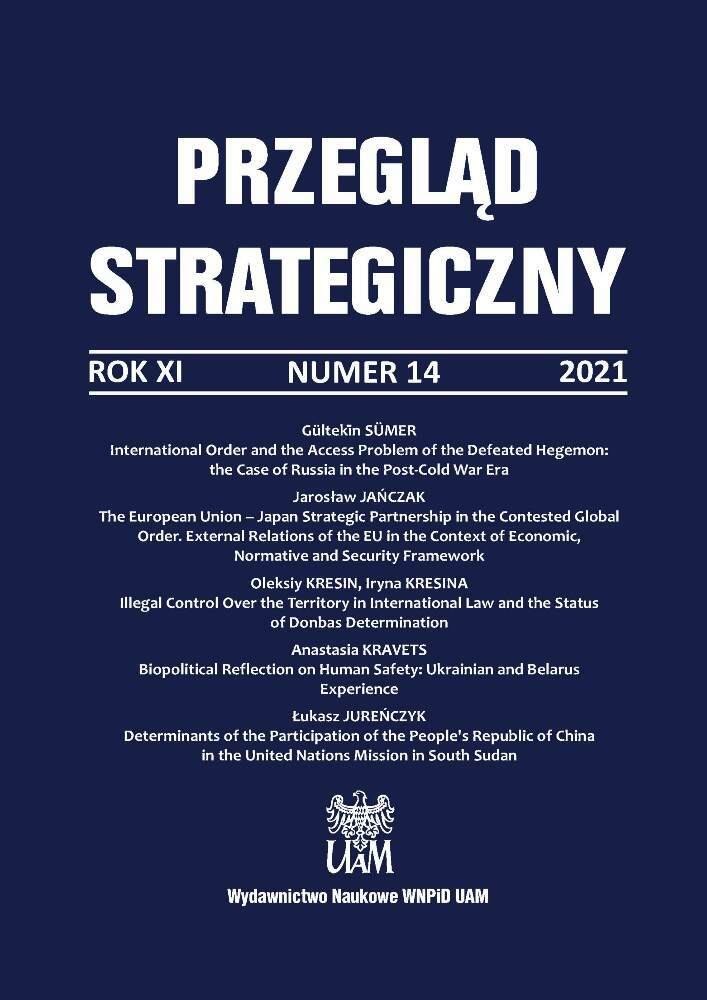Abstrakt
COVID-19 przynosi doniosły spadek globalnego rozwoju gospodarczego, a jego konsekwencje dla chińskiej inicjatywy Belt and Road Initiative (BRI) pozostają także nieuchronne. Pomimo wstrząsów gospodarczych pandemii, BRI pozostaje głównym priorytetem dla Chin, co pozwala Pekinowi poprawić łączność regionalną i rozszerzyć zasięg gospodarczy na Europę i amerykańskie wybrzeża. Z drugiej strony, pandemia mocno dotknęła gospodarki Azji Środkowej, w związku z ograniczeniem handlu regionalnego, spadkiem cen ropy naftowej i jej towarów, głębokim spadkiem przepływów pieniężnych oraz słabnącą zdolnością produkcyjną. Ożywienie BRI i jego natychmiastowy sukces jest pożądany. Dzieje się tak, ponieważ BRI połączył region w zakresie rozwoju infrastruktury, gdzie Chiny, pod nazwą BRI, inicjują duże projekty rozwojowe, inwestując inwestycje w sektor energetyczny, oferując zadłużenie i poprawiając dwustronny handel z regionalnymi gospodarkami. Z tego powodu kraje Azji Środkowej pragną natychmiastowego ożywienia oraz bliskiej współpracy gospodarczej, która mogłaby powiązać losy gospodarcze krajów regionalnych z Pekinem i wysunąć BRI na pierwszy plan w priorytetach regionalnych. Artykuł podkreśla wpływ COVID-19 na gospodarki Azji Środkowej, znaczenie BRI dla regionu; jego geopolityczne znaczenie dla Chin; oraz rosnące wpływy chińskie w post-pandemicznej Azji Centralnej za pomocą teorii siły symbolicznej Bourdieu. Wreszcie, korzystając z jakościowej analizy treści, artykuł argumentuje, że wpływ gospodarczy COVID-19 jest krótkoterminowy oraz ograniczony, i tylko zwiększy perspektywy dla BRI w post-pandemicznej Azji Środkowej, z istotnymi strategicznymi narzędziami dla profilu geopolitycznego Chin w regionie.
Bibliografia
Akhal-Teke (2020, August 5), Turkmenistan: Hiding from Sstellites, Retrieved from Eurasianet: https://eurasianet.org/turkmenistan-hiding-from-satellites.
Aminjonov F., et al., (2019), Report. Norwegian Institute of Inernational Affairs.
Belt and Road Initiative in Central Asia and Caucasus (2019), The World Bank, Washington D.C.
Bourdieu P. (1989), Social Space and Symbolic Power. Sociological Theory, 14–25.
China says one-fifth of Belt and Road projects ‘seriously’ affected by pandemic (2020, June 19), Retrieved from Rueters: https://www.reuters.com/article/us-health-coronavirus-china-silkroad-idUSKBN23Q0I1.
China, Tajikistan concludes joint anti-terrorism drill (2019, August 16), Retrieved from China Military Online: http://eng.chinamil.com.cn/view/2019-08/16/content_9592237.htm.
China’s Post-COVID-19 Palns for Central Asia (2020, April 22), Retrieved from Institute for War and Peace Reporting: https://iwpr.net/global-voices/chinas-post-covid-19-plans-central-asia.
China’s trade with BRI countries surges to $1.34 trillion in 2019 (2019, January 15), Retrieved from The Economic Times: https://economictimes.indiatimes.com/news/international/business/chinas-trade-with-bri-countries-surges-to-1-34-trillionin2019/articleshow/73271222.cms?utm_source=contentofinterest&utm_medium=text&utm_campaign=cppst.
Chronology of China Belt and Road Initiative (2015), The State Council of People’s Republic of China, Beijing.
Coronavirus economic watch: Central Asia and the Caucasus, August 2020, (2020, August 31), Retrieved from Eurasianet: https://eurasianet.org/coronavirus-economics-watch-central-asia-and-the-caucasus-august-2020.
COVID-19 in the Kyrgyz Republic: Assessing the Impact on Socioeconomic Situation and Vulnerability and Policy Responses (2020), Asian Development Bank.
Full Text: Fighting COVID-19: China in Action (2020, June 7), Retrieved from The State Council of the People’s Republic of China: http://english.www.gov.cn/news/topnews/202006/07/content_WS5edc559ac6d066592a449030.html.
Gupta D. P. (2020, December 11), The Economic Impact of COVID-19 in Central Asia, Retrieved from Vivekananda International Foundation: https://www.vifindia.org/article/2020/december/11/the-economic-impact-of-covid-19-in-central-asia.
Hashimova U. (2020, August 3), China Changes Diplomatic Style in Central Asia Over COVID-19, Retrieved from The Diplomat: https://thediplomat.com/2020/08/china-changes-diplomatic-styles-in-central-asia-over-covid-19/.
Hatipoglu M., Gokmen E. (2019, November 7), First China Railway Express line train reaches Turkey, Retrieved from Anadolu Agency.
Huaxia (2020, July 16), Chinese FM C+C5 foreign ministers video meeting, Retrieved from Xinhuanet: http://www.xinhuanet.com/english/2020-07/16/c_139218224.htm.
Ibragimova K. (2019, October 30), Tajikistan approves Chinese $360 million grant for highways, Retrieved from Eurasianet: https://eurasianet.org/tajikistan-approves-chinese-360-million-grant-for-highways.
Karlis T., et al. (2019), The Belt and Road Initiative: A Geopolitical Analysis, IAM 2019 Conference (p. 7), IAM, Athens, Greece.
Kenderdine T. (2020, July 11), China Missteps with Wild Allegation of a ‘New’ Deadly Pneumonia in Kazakhstan, Retrieved from The Diplomat: https://thediplomat.com/2020/07/china-missteps-with-wild-allegation-of-a-new-deadly-pneumonia-in-kazakhstan/.
Khan F. (2020, April 23), COVID-19 Outbreak: Geopolitical Tiderbox, Retrieved from The Frontier Post: https://thefrontierpost.com/covid-19-outbreak-geopolitical-tinderbox/.
Laruelle M. (2018), China’s Belt and Road Initiative and Its Impact on Central Asia, Central Asia Program, Washington D.C.
Overland I. (2016), Energy: The missing link in globalization. Energy Research in Social Sciences: 122–130.
Peyrouse S. (2020, May 1), Understanding Sinophobia In Central Asia, Retrieved from The Diplomat: https://thediplomat.com/2020/04/understanding-sinophobia-in-central-asia/.
Radjabov B. (2020, June 4), Post-COVID-19: Challenges and Opportuntiies for Central Asia, Retrieved from Central Asia-Caucasus Institute: https://www.cacianalyst.org/publications/analytical-articles/item/13622-post-covid-19-challenges-and-opportunities-for-central-asia.html.
Report of the State Committee o Republic of Uzbekistan for Statistics (2020), State Committee Republic of Uzbekistan, Tashkent.
Scissors D. (2020, July 16), China’s Global Investment Vanishes under COVID-19, Retrieved from American Enterprise Institute: https://www.aei.org/research-products/report/chinas-global-investment-vanishes-under-covid-19/.
Sim L.-C., Aminjonov F. (2020, February 1), Potholes and Bumps Around the Silk Road Economic Belt in Central Asia. The Diplomat.
Standish R. (2020, May 28), China Seen as Rising Military Power in Central Asia, Forshadowing Future Friction with Russia, Retrieved from Radio Free Europe: https://www.rferl.org/a/china-seen-as-rising-military-power-in-central-asia-foreshadowing-future-friction-with-russia/30639964.html#:~:text=This%20shift%20can%20be%20seen,to%202014%2C%20the%20report%20says.
Standish R. (2020, July 26), Coronavirus Crisis Accelerates China’s Grab for Power, Influence in Central Asia, Retrieved from Radio Free Europe: https://www.rferl.org/a/coronavirus-crisis-accelerates-china-s-grab-for-power-influence-in-central-asia/30747653.html.
Sukhakin S. (2020), The Security Component of the BRI in Central Asia, Part One: Chinese and Regional Perspectives on Security in Central Asia, China Brief: 29–34.
Sukhankin S. (2020), Chinese Private Security Contractors: New Trends and Duture Prospects, Chna Brief: 18–24.
Tata S. (2017, January 14), Deconstructing China’s Energy Security Strategy, Retrieved from The Diplomat: https://thediplomat.com/2017/01/deconstructing-chinas-energy-security-strategy/.
The August issue of the “Export Review” was presented (2020, August 31), Retrieved from CAERC: http://iqtisadiislahat.org/news/ixrac_icmali_nin_avqust_sayi_teqdim_edilib-1014.
The Belt and Road Initiative in the global trade, investment and finance landscape (2021, February 17), Retrieved from OECD Business and Finance Outlook 2018: https://www.oecd-ilibrary.org/finance-and-investment/oecd-business-and-finance-outlook-2018_9789264298828-en.
Vangeli A. (2018), Global China and Symbolic Power: The Case of 16 + 1 Cooperation, “Journal of Contemporary China”: 674–687.
Vision and Actions on Jointly Building the Silk Road Economic Belt and the 21st-Century Maritime Silk Road (2015, March 28), Retrieved from Ministry of Foreign Affairs of the People’s Republic of China: https://www.fmprc.gov.cn/mfa_eng/zxxx_662805/t1249618.shtml.
Yellinek R. (2020, February 26), The Impact of China’s Belt and Road Initiative on Central Asia and South Caucasus, Retrieved from CSS Blog Network: https://isnblog.ethz.ch/trade/the-impact-of-chinas-belt-and-road-initiative-on-central-asia-and-the-south-caucasus.
Yu C. (2020, August 20), Has China’s Belt and Road Initiative Intensified Bilateral Trade Links Between China and the Involved Countries?, Sustainability MDPI: 3.

